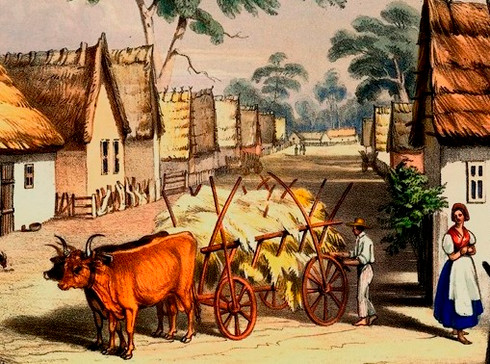 Loading... Please wait...
Loading... Please wait...All prices are in All prices are in AUD
Categories
- Home
- Giclee Prints
- Giclee Angas South Australia Illustrated Klemsic German
- Home
- Giclee Prints
- South Australian Scenes
- Giclee Angas South Australia Illustrated Klemsic German
- Home
- Giclee Prints
- South Australian Scenes
- George French Angas 1846-47
- Giclee Angas South Australia Illustrated Klemsic German
Product Description
Giclee, Limited Edition, George French Angas, South Australia Illustrated, Klemzic, Klemzig, August Kavel, German settlers, Adelaide
"Klemsic. A Village of German Settlers near Adelaide" (South Australia, circa 1846)
Archival limited edition giclee print ( /300) after the original hand colored lithograph by J.W. Giles after artist George French Angas for his ambitious publication "South Australia Illustrated" in 1846-47.
Size of Image 30cm x 35cm ( 12 x 14 inch)
Issued with Limited Edition Certificate.
Accompanying text description:
“'About three miles from Adelaide is situated the picturesque village of Klemzic, on the banks of the Torrens: it is entirely populated by one of the various bodies of Prussian Emigrants ... their houses and cultivation are in the style of their own country ... Poultry, butter, vegetables, and fruit, are frequently brought into Adelaide for sale by the women, whose picturesque style of dress, and simplicity of manners, obtain for these peasants a considerable share of custom'. (note the various spelling of the Klemzic in the text and Klemsic in the print title). Angas' view illustrates the farmhouses of the village and their allocation of thin parcels of land as was traditional to the settler's homeland. The buildings are constructed of mud & straw walls and thatched roofs. To the left is Pastor August Kavel's Church. In the center of this rural peasant scene are two horned bullocks pulling a dray of hay.
"South Australia Illustrated" by George French Angas (1822-86)
Originally published in London between 1846 - 47, the hand colored lithographic prints were sold to 200 subscribers, eager to see what this brave British prototype freely-settled colony had to offer after a decade of settlement. How many of those 200 original hand colored lithographs still exist has prompted issuing this high quality light-safe inkjet process printed on cotton conservation paper. South Australia was to be "A Paradise of Dissent", along with many other ideals that follow in the wake of European Age of social enlightenment. As a free colony, denominational barriers were considered an impediment for desirable, hardworking immigrants required considering the lack of convict labor.
Frederick William III, Prussian Union, the Old Lutherans, August Kavel and the Village of Klemzic
Born in Berlin, Prussia, in 1826 August Kavel became the pastor of the Lutheran Church in the village of Klemzig, Province of Brandenburg. At first he agreed, later was reluctant, to support, King Frederick William III decision to unite the Lutheran & Calvinist (Reformed) churches to form the United Church of Prussia. Kavel used his persuasive preaching-style to benefit a minority known as the “Old Lutherans” of Silesia, who steadfastly refused to forsake their traditions. The Crown set about silencing this Lutheran minority with military force, church closure and pastors’ imprisonment or exile. This created the cause and effect of German migration to the non-denominational Colony of South Australia. In 1836 Kavel met with George Fife Angas, Chairman of the South Australia Company, in England. Angas was keen to settle German agricultural workers in this convict-free British colony. Angas Senior had purchased many of the unsold blocks from Colonel Light’s Town & District Surveys. He assisted the Lutherans with a loan to pay for their passage, that was later paid back with interest. The first Germans arrived on the Prince George in October 1837. Angas Senior had personally purchased Lot 477 off Colonel Light’s Plan, located on the River Torrens. This was the location of the Village of Klemsic/Klemzic so named after Kavel’s Bradenburg village of Klemzig. George French Angas also illustrated Bethany & Lyndoch in the Barossa Hills (Ranges), where the migrants from Prussia, Brandenburg, Posen and Silesia who found the land more fertile. On their arrival they laid out traditional Prussian villages as seen in Angas' view of Klemsic.












